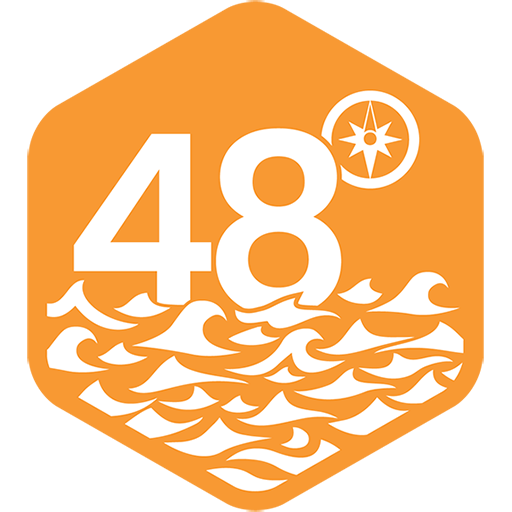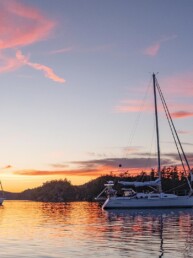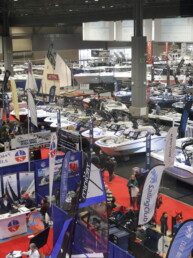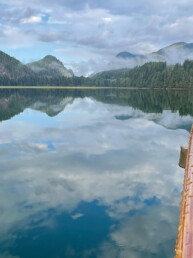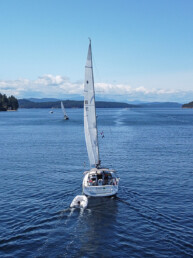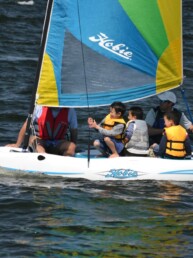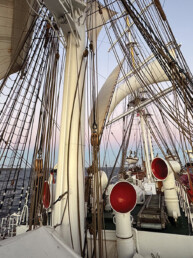I lounged in the cockpit of my friend Ed’s elegant Tiara Coronet 3100, swaying gently on the hook on the north side of BC’s Russell Island on the third day of the 48° North Cruising Rally. We had just strolled the island, were awestruck by the thousand-year-old clam gardens, explored the historic homestead and orchard, and had returned to Ed’s boat where we were relishing happy hour refreshments (with ice!) and casual boat-centric conversation. Our great hardship was having to intermittently adjust the umbrella that was shielding us from the exquisite afternoon sun. It was about as good as it gets.
Soon, my pal and rally co-conspirator, Chuck, pulled up to the swim-step in the dinghy. The small-talk was cut short when he informed us, “There’s been a major earthquake off the coast of Russia, an 8.8. A tsunami could be possible.” Whoa. We had cell service, and every face immediately bowed over the nearest screen with hope of learning more.
We quickly began the “what if” scenarios. Our rally fleet was anchored in 20-30 feet of water with, frankly, questionable holding—when setting, we drug anchor on a rocky shelf twice before finally finding a decent hold on the third try. We discovered that the standard tsunami recommendation is to head for deeper water, far from obstructions. Some internet sleuthing turned up predictions suggesting likely the likely arrival window would be between 11:30 p.m. to 1:30 a.m. that night.
So then, I grilled steaks. With several hours before any possible tsunami activity, we gathered in the perfect summer twilight for a potluck aboard the biggest boat on the rally, a magnificent Waterline 50—weather, surroundings, and company way too nice for the end of the world. Over dinner, as you might expect, there was plenty of discussion about the prospects of a tsunami and what we should do. Emergency BC’s Tsunami Advisory showed a zone map of affected areas that ended at the island just a couple miles south of where we were. We talked a lot about how even a small wave could amount to a significant current effect, but were optimistic that reports from the coast might give us a sense of what was to come.
By the time everyone dinghied back to their boats, we had a plan. The risks didn’t seem high enough to assign everyone an all-nighter underway in deep water. We’d wait and see, with phones and VHFs on, and I’d stay awake through the window to communicate relevant news. If there was any kind of event, we’d pull anchor rapidly, gather a few hundred yards outside the anchorage, and head together to nearby Swanson Channel.
Back on my rally ride, I set out lifejackets, tethers, and lights on the salon table and incessantly refreshed news in every way I could. I checked government websites in the US and Canada. Channel 16’s blanket VHF tsunami advisory popped up every half hour. Eventually, a 4-foot wave reportedly hit Hawaii, but there were no reports on the west coast of North America. The time for landfall at Neah Bay came and went, no news. Port Angeles, nothing. Port Townsend and Victoria, silence. I was pretty disappointed that there were so few updates, but I hoped it meant that any real worry was dissipating.
By 1:45, I started to doze, awakened by the slightest rock of the boat or periodic VHF call, prompting me to check our Navionics track to see if we’d dragged. At 2:30, I turned off the VHF and slept restlessly. I awoke relieved to see through the morning haze that we were in the same spot, and all rally boats were safely nearby. Another rally participant heard a VHF alarm around 3 a.m. and thought they felt a small wave.
Our blissful week of cruising in the San Juan and Gulf islands had included a real-life tsunami drill. As is often true in cruising and sailing, to appreciate the boundaries of your knowledge and experience—and how little you actually can control—all you need to do is pay attention. How would you have addressed that little pickle?
Title background photo of 48° North Rally boats anchored at Russell Island by Joe Cline.
Joe Cline
Joe Cline has been the Managing Editor of 48° North since 2014. From his career to his volunteer leadership in the marine industry, from racing sailboats large and small to his discovery of Pacific Northwest cruising —Joe is as sail-smitten as they come. Joe and his wife, Kaylin, have welcomed a couple of beautiful kiddos in the last few years, and he is enjoying fatherhood while still finding time to make a little music and even occasionally go sailing.
